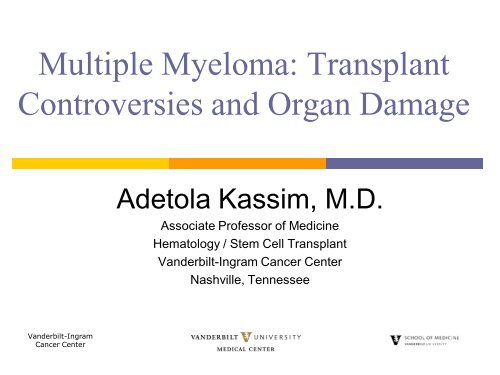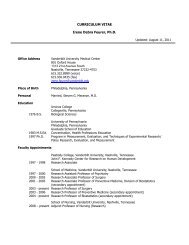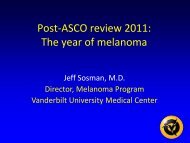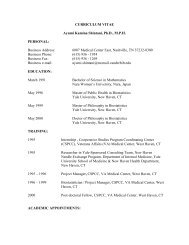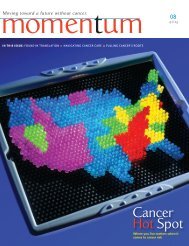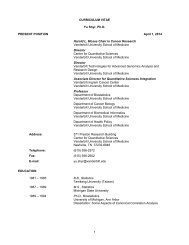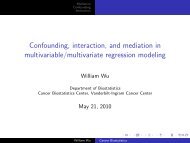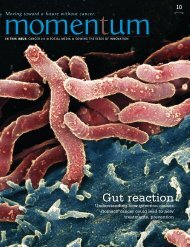Multiple Myeloma: Transplant Controversies and Organ Damage
Multiple Myeloma: Transplant Controversies and Organ Damage
Multiple Myeloma: Transplant Controversies and Organ Damage
Create successful ePaper yourself
Turn your PDF publications into a flip-book with our unique Google optimized e-Paper software.
<strong>Multiple</strong> <strong>Myeloma</strong>: <strong>Transplant</strong><strong>Controversies</strong> <strong>and</strong> <strong>Organ</strong> <strong>Damage</strong>Adetola Kassim, M.D.Associate Professor of MedicineHematology / Stem Cell <strong>Transplant</strong>V<strong>and</strong>erbilt-Ingram Cancer CenterNashville, TennesseeV<strong>and</strong>erbilt-IngramCancer Center
Disclosures: Adetola Kassim, M.D.I have the following financial relationships to discloserelevant to the content of this presentation:• Advisory Board: Millennium, Celgene, NovartisV<strong>and</strong>erbilt has determined that there are no conflicts ofinterest.
Presentation Outline Stem Cell <strong>Transplant</strong>ation- Autologous- Allogeneic- Consolidation + Maintenance <strong>Organ</strong> <strong>Damage</strong>- Bone disease- Peripheral neuropathy- Renal Disease
Pre-<strong>Transplant</strong> Novel Agents <strong>and</strong> AHCTOutcome – ASH Abstract 1347, Osman et. al Impact of pre-transplant remission status on AHCToutcome: Thalidomide/Lenalidomide/Boretzomib N = 63; median age 53 yrs (44 – 72); 63% male 66% DS stage III; 34% stage I/II; KPS 90; HCT-CI – 0 Pts had single AHCT; Mel200 (140 S.Cr >2mg/dl) 31pts with PR -> 15 CR, 2 VGPR, 14 PR <strong>and</strong> 1 SD 17pts with CR remained in CR s/p AHCT 6 pts VGPR -> 2 CR, 14 maintained VGPR 9 pts SD -> 5 CR, 3 PR, 1 SD
Pre-<strong>Transplant</strong> Novel Agents <strong>and</strong> AHCTOutcome – ASH Abstract 1347, Osman et. alMedian follow-up of 36 monthsComparison groups N = 63 OS P PFS PP vs No-P-group 54 / 9 58 / 60% 0.93 22 / 31% 0.74V vs No-V-group 40 / 23 44 / 62% 0.53 22 / 24% 0.72All patients NRM = 5%
Long-Term Follow-up: T<strong>and</strong>em auto-allo vs autoautoin newly diagnosed myeloma, Italianexperience. Bruno et. al, ASH Abstract # 525 162/199 (81%) of patients were HLA-typed. Induction with VAD-based regimens; median f/up of7.3yrs (range 5.4 – 10.7+ years) 58/46 patients received auto-allo vs auto-auto Median OS NR/5.3yrs (HR 0.55, CI 95% 0.32-0.94,p=0.02), whereas EFS was 39/33 months (HR 0.62, CI95% 0.40-0.96, p=0.02) respectively. TRM was 11% <strong>and</strong> 2% at 2 years respectively. CR rate was: 55% versus 26% (p=0,0026), Having an HLA matched sib, correlated with OS/EFS
T<strong>and</strong>em Autologous Stem Cell <strong>Transplant</strong>s (auto-auto) with orwithout Maintenance Therapy versus Single Autologous <strong>Transplant</strong>Followed by HLA-Matched Sibling Non- MyeloablativeAllogeneic Stem Cell <strong>Transplant</strong> (auto-allo) for Patients (pts) withHigh Risk (HR) <strong>Multiple</strong> <strong>Myeloma</strong> (MM): Results from the Blood<strong>and</strong> Marrow <strong>Transplant</strong> Clinical Trials Network(BMT-CTN) 0102 TrialEdward A. Stadtmauer, Amrita Krishnan, Marcelo Pasquini, MarianEwell, Joseph Antin, Hugo Castro-Malaspina, Adetola Kassim,Robert Negrin, Muzaffar Qazibash, J. Douglas Rizzo, Scott Rowley,Firoozeh Sahebi, David Vesole, Dan Vogl, Daniel Weisdorf, NancyGeller, Mary M. Horowitz, David Maloney, Sergio GiraltOn behalf of the Blood <strong>and</strong> Marrow <strong>Transplant</strong> Clinical Trials Network
BMT-CTN 0102 Trial Phase III multicenter trial that biologically assignedpatients to auto-auto (+ 1 year of ThalDex) vs auto-allo HR = -13q deletion <strong>and</strong> beta-2 microglobulin >4 mg/dl 85 HR, 48 auto-auto (24 ThalDex; 24 Obs); 37 auto-allo 59 (31 auto-auto, 28 auto-allo): median age 57 vs 51yr; Compliance with ThalDex was poor in auto-auto 3yr PFS 35% vs 46% (p=0.6); TRM 8% vs 20% Equivalent 3yr PFS <strong>and</strong> OS in both groups Trends in late PFS, TTP <strong>and</strong> relapse need follow-up
Proportion SurvivingBMT-CTN 0102 Trial(b) Progression Free Survival Post First <strong>Transplant</strong>. High Risk Group.10.90.80.795% CI at 3 years0.60.50.40.330.270.22p-value=0.740.60.50.4Auto/Allo0.30.2Auto/AutoNumber at risk:48 39 33 23 20 17 14 3 2 Auto/Auto37 30 20 18 15 14 13 4 4 Auto/Allo0 6 12 18 24 30 36 42 48 54 60Month Post 1st <strong>Transplant</strong>
Reduced Intensity Conditioning (RIC) AllograftStrategies in <strong>Myeloma</strong>: ASH Abstract # 3512, Sahebi et. Al Retrospective analysis of EBMT database; n = 504 Auto-allo (253/356) vs early RIC-allo (148) as first SCT Early RIC pts were younger (51 vs. 53 yrs; p=0.03); 51%had SCT between 1998-2002 vs. 33% (P CR at HCT (17% vs. 9% P=0.008). Median follow-up of 52 months, auto-allo had best CR62 vs. 47%; PFS 31 vs 17%; OS at 5ys 60 vs 37% (p
Role of Reduced Intensity Conditioning (RIC) Allograftin Relapsed <strong>Multiple</strong> <strong>Myeloma</strong> after Autograft:Donor vs No Donor: ASH Abstract #3534, Patriarca et. Al 169 pts; 24 sibling donor (35%), 44 MUD (75%). Median age: donor vs no donor (53/59 years, p
Phase 3 Study Evaluating Lenalidomide Maintenance inPatients > 65 years with Newly Diagnosed <strong>Multiple</strong><strong>Myeloma</strong> (NDMM): ASH Abstract 622, Palumbo et. al. 459 pts; stratified by age <strong>and</strong> ISS stage R<strong>and</strong>omized to receive MPR-R, MPR or MP Primary comparison was MPR-R vs MP Update of 70% interim analysis at 21 months MPR-R vs MP reduced the risk of disease progressionby 58% (HR 0.423, P < .001) <strong>and</strong> MPR-R vs MPR by69% (HR 0.314, P < .001); limited follow-up for OS ORR, CR, VGPR <strong>and</strong> PFS better with MPR-R Discontinuation due to AEs 20 <strong>and</strong> 8%
Lenalidomide MaintenanceLong-Term Maintenance with Lenalidomide Improves PFS in<strong>Multiple</strong> <strong>Myeloma</strong> patients with High Rsk Cytogenetics:An IFM study. ASH Abstract #1944: Herve Avet-Loiseau. et al.- Median PFS for del(4;14), del(17p) <strong>and</strong> placebo were 27, 29 <strong>and</strong>14 months respectively, favoring ―no abnormality‖Lenalidomide Maintenance Following Non MyeloablativeAllogeneic Stem Cell <strong>Transplant</strong> in Patients with <strong>Multiple</strong><strong>Myeloma</strong>: Results of the HOVON 76 study:ASH Abstract #3502: Minnema et. al.- 35 pts treated with 10mg lenalidomide 21/28 days x 24 mths- 10pts responses: 5 PR -> 3 VGPR, 2 CR; 5 VGPR -> CR- 63% acute (late onset) GvHD; PFS similar to HOVON 54 study
Weekly Maintenance Bortezomib s/p Auto-PBSCT in<strong>Multiple</strong> <strong>Myeloma</strong>: Results of a Phase II ProspectiveStudy. ASH Abstract #2399, Sahebi et. al 39/45 received bor/dex, 4-8 weeks s/p PBSCT 25 pts completed planned 6 months of Rx At 6 mths15/25 pts (60%) achieved CR; 9/25(36%) upgraded their response with bor/dex. 8 pts (24%) d/c due to toxicities; at 1 year,14/28 pts (50%) remain in CR. 8 pts developed new PN, all are grade I-II. Median bortezomib dose is 1.3 mg /m 2 / week.
Effect of Thalidomide Maintenance on PFS <strong>and</strong> OS in<strong>Multiple</strong> <strong>Myeloma</strong>: MRC <strong>Myeloma</strong> IX Results.ASH Abstract #623, Morgan et. al 818/820 evaluable; median age 65 yrs (31−89). Median f/up was 38 months (12−66). Median time on maintenance 7 months (0−50). Improved PFS by 13% (CI 6%−20%) from 24 -66 months (HR 1.36; CI 1.15−1.61; P < 0.001). However, no apparent impact on OS (P = 0.40). No response upgrade or impact of novel agents
Consolidation Therapy in <strong>Multiple</strong> <strong>Myeloma</strong>:ASH Abstract #861, Terragna et. al. Molecular sub-study to the phase 3 GIMEMA trial Induction with VTD vs. TD -> T<strong>and</strong>em-Auto -> twoconsolidation therapy with VTD or TD starting 3 monthsafter ASCT(s), independently from prior response 67/84 pts were analyzed for MRD by qPCR Upgrade in PCR-ve 37.5% ->52% with TD consolidation<strong>and</strong> 43% -> 67% with VTD consolidation (p=0.05). Post-consolidation PCR-ve >VTD vs. TD (p=0.05). Median 1 log reduction in tumor burden with TDconsolidation vs. a median 5 log reduction with VTDconsolidation (p=0.05) .
Bone Destruction <strong>and</strong> <strong>Myeloma</strong> Growth—aStimulatory LoopOsteolytic lesionBPBone matrixOsteoclastOsteoblastTGF-bFGF-1&2IGF-1&2PDGF<strong>Myeloma</strong> cellsRANKLTNF-bIL-1bIL-6Stromal cells17
MRC <strong>Myeloma</strong> IX-AnalysisSchematic for ZOL vs CLON = 1,960Patients with newlydiagnosed MM(stage I, II, III)RANDOMISATIONZoledronic acid (4 mg a IV q 3-4 wk) +intensive or non-intensive chemotherapy(n = 981)Bisphosphonate treatment continued at leastuntil disease progressionClodronate (1,600 mg/d PO) +intensive or non-intensive chemotherapy(n = 979)Endpoints (ZOL vs CLO)Primary: PFS, OS, <strong>and</strong> ResponseSecondary: SREs (time to first SRE, SRE incidence) <strong>and</strong> SafetySREs were defined as vertebral fractures, other fractures, spinal cord compression,<strong>and</strong> the requirement for radiation or surgery to bone lesions, or the appearance ofnew osteolytic bone lesions.Abbreviations: CLO, clodronate; IV, intravenous; MM, multiple myeloma; OS, overall survival, PFS, progression-free survival; PO, oral;18SRE, skeletal-related event; ZOL, zoledronic acid.aDose-adjusted for patients with impaired renal function, per the prescribing information.
MRC <strong>Myeloma</strong> IX - Study Endpoints Primary endpoints• Overall survival (OS)• Progression-free survival (PFS), defined as time fromr<strong>and</strong>omisation to disease progression or death• Response Secondary endpoints• Proportion of patients with an SRE; SRE timing• Safety Statistical methods• PFS <strong>and</strong> OS were assessed by Kaplan-Meier <strong>and</strong> Coxproportional hazards models• Statistical significance was assigned for P < .05 with no correctionfor multiplicity of comparisons
MRC <strong>Myeloma</strong> IX- Trial Status N = 1960; 121 centers in the UK Median follow-up: 3.7/3.8 years – ZOL/CLO Median time on study drug (days)- Intensive: 396 ZOL; 409 CLO- Non-intensive 320 ZOL; 306 CLO Off-study:- Progressed or died: 59.5% ZOL; 64% CLO- Stopped before progression:24% ZOL <strong>and</strong> 19% CLO
MRC <strong>Myeloma</strong> IX Study – ASCO Update 28% on ZOL <strong>and</strong> 26.7% on CLO- no bone disease (BD-) PFS amongst BD+: 20.4 vs 18 mo (HR = 0.90; P= .101);BD- pts: no difference for ZOL vs CLO (18 mo each; HR= 0.99; P = .885). ZOL improved PFS (HR = 0.88; P = .0179) vs CLO Overall, risk of SRE was 0.36 for CLO <strong>and</strong> 0.29 for ZOLwith BD (a 19% reduction), <strong>and</strong> 0.12 for CLO <strong>and</strong> 0.07for ZOL in pts without BD (42% reduction).ASCO 2011: Abstract #8010, Boyd et. al.
Cumulative Incidence FunctionMRC <strong>Myeloma</strong> IX—ZOL Maintained Trendto 1st SREs vs CLO Beyond 3 Years0.200.15P = .1012 log–rank0.100.05CLOZOL3 years00 6 12 18 24 30Time Since 3-Years Post-r<strong>and</strong>omisation, monthsPatients, nZOL 190 133 92 61 32 15CLO 162 105 78 48 25 9Abbreviations: CLO, clodronate; SRE, skeletal-related event; ZOL, zoledronic acid.ASCO 2011: Abstract #8011 Davies et. al.
MRC <strong>Myeloma</strong> IX Study – ASCO Update:Benefits to long-term bisphosphonate treatment In MMIX, Median OS was 5.5 months longer with ZOL vsCLO (hazard ratio [HR]=0.84; 95% CI, 0.736, 0.963;P=.012). OS benefit from ZOL vs CLO was especially profoundduring the first 4 months ZOL significantly reduced the risk of death by 36%relative to CLO (HR=0.64; P=.004).ASCO 2011: Abstract #8011 Davies et. al.
MRC <strong>Myeloma</strong> IX- ZOL OS <strong>and</strong> PFS vs CLO(Overall Population)OS (overall)0.842Riskreduction16%P value.01185.5 months(adjusted for SRE) a0.85015%.0178PFS (overall)0.88312%.01792.0 months0 0.2 0.4 0.6 0.8 1 1.2 1.4 1.6 1.8 2Hazard ratio (ZOL versus CLO)In favour of ZOLIn favour of CLOAbbreviations: CLO, clodronate; OS, overall survival; PFS, progression-free survival SRE, skeletal-related event; ZOL, zoledronic acid.Time to first SRE was included as a time-dependent covariate in an exploratory Cox modelexamining OS.Data from Morgan GJ, et al. Lancet. 2010;376(9757):1989-1999.
Comparative Effectiveness ofBiphosphonates in <strong>Multiple</strong> <strong>Myeloma</strong> 18 RCTs were included enrolling 4,970 patients. Only 3RCTs employed head to head comparison ofbisphosphonates in patients with MM using MTC. OS: ZOL > CLO <strong>and</strong> Eti; PFS: ZOL > CLO SRE: ZOL > CLO, IBAN, PAM Incidence of ONJ was higher in zoledronate [OR: 12.03(95% CI: 3.68 to 39.26)] compared to clodronate. Efficacy: ZOL > CLO > PAMASH 2010: Abstract #3028, Mhaskar et. al.
Comparative Effectiveness ofBiphosphonates in <strong>Multiple</strong> <strong>Myeloma</strong>Comparison Outcome HR 95%CI Numberneeded totreat (range)ZOL vs. CLO OS 0.83 0.73 - 0.94 15 (9 -35)ZOL vs. ETI OS 0.48 0.31 – 0.71 4 (3 - 8)ZOL vs. IBAN OS 0.70 0.42 – 1.11 ---------ZOL vs. PAM OS 0.84 0.61 – 1.13 ---------ZOL vs. CLO PFS 0.88 0.78 -0.99 21 (11 – 270)ZOL vs. PAM PFS 0.93 0.32 - 2.17ZOL vs. CLO SREs 0.75 0.64 – 0.88 13 (8 – 16)ZOL vs. ETI SREs 0.74 0.29 – 1.61ZOL vs. IBAN SREs 0.44 0.26 – 0.72 4 (3 – 10)ZOL vs. PAM SREs 0.65 0.42 – 0.95 12 (6 – 86)ASH 2010: Abstract #3028, Mhaskar et. al.
Evaluation of Peripheral Neuropathy (PN)(PASS) of Lenalidomide vs Other Therapies inPatients with R/R <strong>Myeloma</strong>. Prospective study, 1011 pts with MM in 177institutions in 15 European countries Baseline PN- 39% in Lenalidomide (22% due toprior bortezomib, 15%-thalidomide); 21% inBortezomib (3%-bortezomib, 13%-thal, 2%-vincristine, non-drug- 4-6%) Patient discontinuation due to AEs: Thal-24.5%;Lenalidomide 14.1% <strong>and</strong> bortezomib 15.5%ASH 2010: Abstract #1939, Delforge et. Al.
AEs in Lenalidomide, Bortezomib <strong>and</strong>Thalidomide cohortsPatients with at least one drugrelatedAE, n (%)Patients with at least one drugrelatedAE of PN, n (%)Patients with at least one drugrelatedgrade 3* or 4**AE ofPN, n (%)Patients with at least one AE ofPN leading to treatmentdiscontinuation, n (%)Lenalidomide(n = 658)Bortezomib(n = 207)Thalidomide(n = 53)326 (49.5) 93 (44.9) 37 (69.8)30 (4.6) 41 (19.8) 7 (13.2)7 (1.1) 9 (4.3) 05 (0.8) 10 (4.8) 0*Grade 3: symptomatic (sensory) or weakness (motor), interfering with ADL**Grade 4: disabling:ASH 2010: Abstract #1939, Delforge et. Al.
Baseline PN does not impact the efficacy<strong>and</strong> tolerability of Carfilzomib in R/R MM 89% (n = 266) pts on PX-171-003-AI had h/o PN fromprior therapies (Thal 41%, BTZ 50%, both 6.4%) 77% had G1/2 PN at baseline, MDD 5.9yrs, 5-PLT Median duration of response was 7.4 months (>PR) AEs > primarily hematological 65%; fatigue 7% New or worsening PN uncommon: any grade 15%; G3PN 0.4%, paraesthesias 6.8%; dysesthesias 0% PN has no impact on depth or durability of responsesASH 2010: Abstract #3031, Martin et. Al.
Renal Dysfunction in Newly Diagnosed<strong>Myeloma</strong>: Survival outcome 1478 pts at Mayo Clinic- Jan 1999 – 2009 Median age 64 years; 50% male; median follow-up 3years; 781 pts alive at analysis Serum Cr (sCr) >15 mg/dl 22.5%; >2.5 mg/dl in 10% Median OS if sCr was >1.5 vs 1.5 mg/dl at 4 months ?negative impact of organ dysfunction on survivalASH 2010: Abstract #2970, Kumar et. Al.
Renal Dysfunction in Newly Diagnosed<strong>Myeloma</strong>: Overall survival from Diagnosis1: Cr 1.5 mg/dL at diagnosis but improved to 1.5 mg/dL at diagnosis <strong>and</strong> never recovered to


